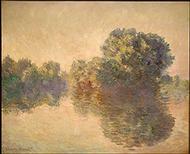
|
Claude Monet (artist) French, 1840 - 1926 The Seine at Giverny, 1897 oil on canvas Overall: 81.5 x 100.5 cm (32 1/16 x 39 9/16 in.) framed: 102.6 x 121.6 x 9.5 cm (40 3/8 x 47 7/8 x 3 3/4 in.) Chester Dale Collection 1963.10.180 |
From the early 1860s until 1889, not a single year passed that Monet did not paint the Seine. Its flower-strewn banks and watery reflections appear in nearly a quarter of all his paintings in the National Gallery. In 1896, though, he began a more systematic study of the river near his home at Giverny. Lured by the lifting haze and quickly changing light of early morning, he rose before sunrise—at 3:30 a.m.—to be at his easel by dawn. He worked from a flat-bottomed boat drawn up near the bank. But, as with his other series paintings, Monet only began the pictures outdoors, elaborating them over a period of months in his studio, taking special pains to adjust their light. These paintings, more precisely than his other series pictures, show the progression of time and the subtle changes in light as hours, even minutes, pass.
This painting is related to the early morning series, but those are more crisply defined. The paint here, although it is often thickly applied on the canvas, gives the impression of transparency, like thin veils of mist. It is this enveloppe that unifies the picture with a vaporous luminosity. Rather than focus on the trees, the line of the water, or sky, Monet subsumes these individual shapes, enveloping forms and reflections alike in the soft light. The surface becomes a decorative pattern of curving arabesques.


